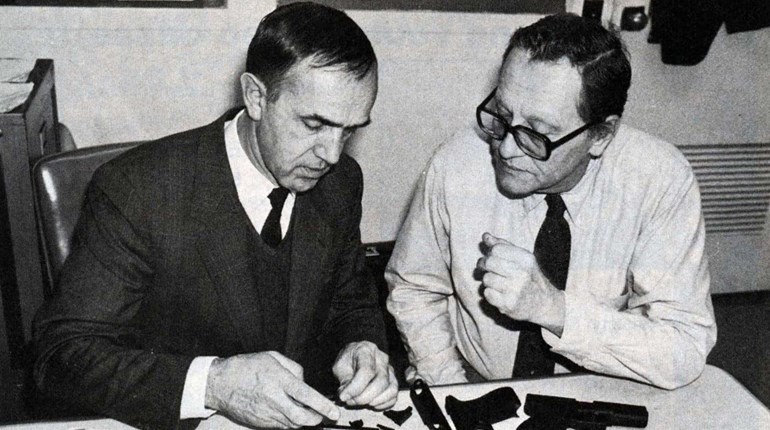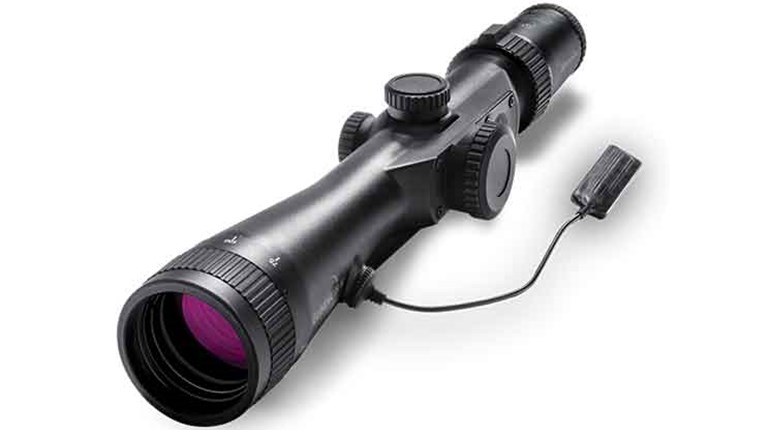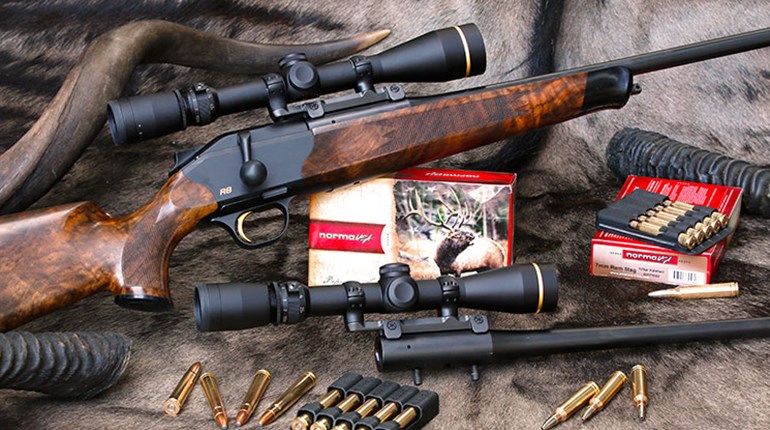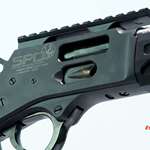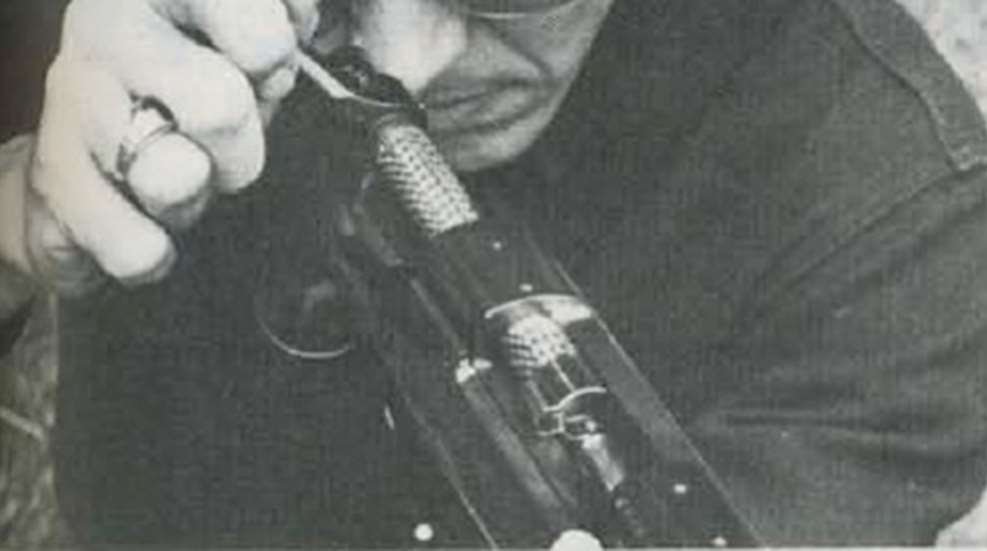
December 1980—American Rifleman.
The Year 1964 has come to be associated as much with the Model 70 rifle as the Winchester name itself. Comments by some shooters might lead one to believe that any Model 70 made after that date is pure junk. Nothing could be further from the truth.
The attitude of collectors is more understandable, as the pre-’64 Model 70 is distinctly different from succeeding models, regardless of year, and forms a fascinating collector field in itself. As time passes, however, the post-‘64s will find their collector niche, as have the postwar Single Action Colt revolvers.
In addition to the two preceding articles in the American Rifleman, there is a good deal of printed matter available on the various models of Winchester’s premium bolt-action. Most of it dwells on production before the fateful 1964, but much information can be had from Dean Whittaker’s The Model 70 Winchester 1937-1964; The History of Winchester Firearms 1866-1966 by Georg R. Watrous; Bill West’s Winchester-Complete; and The Winchester Book by George Madis. The facts as given by the authors do not always coincide, but the comparison of views and statements is interesting in itself and does not detract from the pleasure of studying America’s most famous bolt-action sporter.
One book that has no counterpart—and no flaw that this author is aware of—is Stuart Otteson’s The Bolt Action. This remarkable volume covers, from an engineer’s standpoint, the major turnbolt actions from the M98 Mauser (1898) through the Mossberg Model 810 (1971). There are separate chapters devoted to the Winchester 54, the pre-’64 Model 70 and, finally, a 1968 version of the Winchester. Otteson finds little bad to say of the new versions, and those adversely critical points he does make apply to the pre-’64 version as well; i.e., “1. Action over-long for many calibers; 2. Two-piece trigger guard/floorplate assembly.” Anyone with prime interest in the mechanics of the various Winchesters would do well to study Otteson’s book carefully.
It should be emphasized that Otteson devotes his comments almost entirely to the action per se. He pays little attention to anything forward of the receiver ring. This is precisely the area where, in 1964, Winchester ran into trouble.
Winchester knew by 1960 that, despite its good sales, the Model 70 was becoming too expensive to manufacture and compete with other rifles made on more-modern machinery. By 1962, Winchester was at work on an updated version, and in a remarkably short time had completed, if not perfected, a rifle with an improved action. “Improved” here applies to manufacture as well as design.
Gone was the cone-breech system of the Springfield and previous Winchester models. No one complained, as the coned breech had always been considered a weak point, and the new square breeching left very little of the cartridge head unsupported.
The receiver, though ¼” longer than that of Model 70s of the 1950s, was no heavier, and its feeding rails were not integral with it but were contained in the magazine box. These changes were actually to prove beneficial to those owners who decided to change their guns from one caliber to another, dissimilar one.
The external form of the receiver was not changed, though it was no longer milled form nickel-steel bar stock but forged from chrome-molybdenum steel. Again no one complained.
The bolt body was machined form the same type steel as the receiver—with the familiar dual front locking lugs—and its handle, an investment casting, was securely pressed and brazed in place. There is nothing substandard in this arrangement.
A relatively small hook extractor was housed in the right locking lug, and a plunger-type ejector worked from the bolt face. This tied in neatly with the flat vs. cone breeching, and despite its by-now proven effectiveness came in for much criticism at the time.
For economy reasons, the 1964 models were made without the guide lug on the bolt, but this was found to be an unsatisfactory arrangement. In 1968, an excellent anti-bind device was incorporated in the bolt head.
The magazine/floorplate assembly remained virtually unchanged except for the feeding lips being made integral with the magazine box, as mentioned earlier. Best of all, the Model 70 trigger remained as it was—admirable in every respect and now with a wider finger surface.
With no consideration to nostalgia, then, the actions of the “new” Model 70, or at least those made after 1968, are nothing to be ashamed of but are in fact, if not in reputation, excellent.
Where then did Winchester go wrong 16 years ago and call down the wrath of American shooters? Except for the soon-remedied lack of a bolt guide, the answer seems to lie in the simply ludicrous stock that blurred the eyes of dealers and potential customers alike. If it hadn’t come on the heel’s of the more-than-respectable ’63 vintage woodwork, things might have been too bad—but bad enough.
The 1964 Winchester catalog announced the many actual improvements of the “New ‘Proved on Safari’ Model 70,” but it may have gone too far when it said, “New high-gloss finish plus handsomely checkered grip and foreend are standard on the Model 70.” Actually, the pressed checkering, cunningly glossed over by the finish, looked as though it took third prize in a two-entry contest. It was no more effective in its utility. Winchester went on to say, “Free floating barrel…the same type used in International Free Rifle Matches and bench-rest shooting…you can’t ask for better accuracy than that.” Maybe not, but you could ask for better looks and common sense.
Free floating it was. There was such a gap between the barrel and its channel in the fore-end that the accumulation of twigs and degrees during a normal hunt was almost assured.
Winchester hired a personable African professional hunter to test and promote the new guns, and he attended many gun shows in the U.S. to comment on the results of his experiences. One irritated visitor inserted a finger between barrel and fore-end and testily told the African, “That’s called a channel all right, but it’s for the barrel, not a canoe.”
There was not much Winchester could do about the customer reaction. The new guns, which began with serial No. 700,000, were in inventory and were moved out to dealers. Few of the guns are to be seen in their original form today, however, as the buyers, in many cases, elected to rebed, rechecker, refinish or restock them with all haste. The custom stockmakers were delirious, and Winchester grappled with the problem as best it could. In 1965, the firm offered Model 70 barreled actions as regular catalog items for the first time in its history. The completed rifle line remained the same with the addition of the .225 Win. chambering and the so-called Deluxe model—more pressed checkering plus an ebony grip cap and fore-end tip with white line spacers but select walnut. Only the .458 African held out with cut checkering and non-floating barrel. Its cost was more than twice the price of the standard model, making clear the reason for the change. The new stocks and their installation were simply an economy move, and the savings were being passed on to (or forced on) the customer.
In 1966, Winchester’s centennial year, the 7 mm Rem. Mag. chambering was added, the checkering pattern began to improve—or at least increase in area—and the stock profile was made more attractive. But barreled actions continued to be featured in the catalog.
Also in that year, a new bolt-action, the Model 670, was introduced in seven calibers in both rifle and 19”-barreled carbine versions. In essence, it was a simplified Model 70 with a two-position safety separated from the bolt sleeve, a non-walnut stock, and a blind magazine. Oddly enough, the barrel was not free floating, but was closely bedded to the fore-end. Winchester was experimenting with new approaches to cost cutting.
The year 1967 saw few changes except for the addition of the .22-250 Rem. cal to the hunting line and the .308 Win. to the Target Model. A year later, the new anti-bind bolt was installed, and the action itself was better than ever. The catalog of that year made no mention of the free-floating barrel—indeed the channel had shrunk from a trade route to an acceptable depth this time.
With 1969 came the end of a painful five-year period of Winchester’s stock troubles. The company catalog that year used the terms “positive checkering” or “hand checkering” repeatedly in referring to the Model 70 and the new Model 770 (a compromise between the low-end 670 and the standard model). It was equipped with the Model 670’s blind magazine and the Model 70’s three-position safety and walnut stock.
Together with the welcome change in stock appearance came another version, the 19”-barreled Model 70 with full-length, Mannlicher-style stock. Also added to the standard rifle’s chambering choices was the .222 Rem. cartridge.
There was nothing new to report in 1970 or 1971 except for the International Army Match Rifle in .308 Win. cal. (7.62 mm NATO), which conformed to the UIT requirements.
In 1972, the Model 670 acquired the three-position safety and the 770 turned into the 70A, with a special police version being offered with uncheckered stock in cals. .30-’06 and .308 only. The Deluxe version of the Model 70 was improved and renamed the New Super Grade.
The Mannlicher-styled rifle disappeared in 1973. By 1975, Winchester was quite justified in touting its premium bolt-action as “The Model 70 the way you want it.” It has remained so, and in 1978 it became even more attractive by the XTR cosmetic treatment that Winchester has given its first-line sporting guns. In that year, the 670 model was dropped from the line.
Currently, the Model 70 and its blind magazine companion, the 70A, are available in 13 popular calibers and must be considered among the best hunting rifles of their type available from any source or from any era. If there is any justice, the term pre-’64 Model 70 should be coupled with that of the post-’68 Model 70 as examples of the best bolt-action rifles America has produced.












